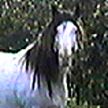
Stallion Acrux Dead At Age 4 |
|||||
 |
|||||
|
Treasure Cay, Abaco . . . The Wild Horses of Abaco suffered the loss of a fine, four year old pinto stallion named Acrux on Thursday, March 4, 1999
Milanne (Mimi) Rehor, president of the Abaco Wild Horse Fund, does not know what caused the injury that led to his death but hopes that inspection of his skull at a later date will provide some clues as to whether the damage came from another horse or some other foreign object(s). Acrux began to decline last July, though inspection of videos and stills after his death indicate an apparently bruised area on the left side of his face in March of ‘98. He was an aggressive fighter and was often badly chewed up. He disappeared periodically, was seen in September of ‘98 with an abscess on his face the size of a cantaloupe melon. By early December the abscess was reduced in size. He disappeared in February, a brief glimpse showed less swelling but odd marks were appearing on his facewhich turned out to be maggot emergence sites. Other than that his body was in good shape. During the last week of February he was seen again but Rehor did not get the report since she was immobilized with the flu. On March 2 she finally saw him and he was in terrible, terrible condition. All his bones showed clearly. Much of his left upper and lower lips were eaten away be maggots. He was weak and stumbling. Gayle Cottman drove Rehor and Dr. Robert Allen of the Caribbean Veterinary Health and Healing Centre to the Bahama Star farm on Wednesday March 3. The right tranquilizers were not available. Since these horses are wild, it takes a much stronger drug than usual to knock them out. It has cost the Fund $300.00 to order a supply of 20 ml to have on hand for future emergencies, and this is only enough for about six horses. Since Acrux was so weak the old tranquilizer got him down but he still was surprisingly powerful. He was given two bags of glucose via an IV drip hung in an orange tree. He was given a shot of penicillin and his wounds were cleaned but the flies were impossible and no doubt were part of his decline since the maggots, after cleaning bad tissue had gone on to destroy living tissue. The damage and swarming flies prevented him from eating and drinking properly. He was showing signs of healing though despite that terrible damage. After treatment he was rolled up on his chest and provided with fresh grass and water. About eight hours were spent between capturing him, treating him and making sure he came out of the tranquilizer. Dr. Allen was optimistic. The next morning Rehor found him about 100 feet from where he’d originally gone down. He was suffering from severe dehydration and could not get up. The flies were unbelievable. Rehor asked a police officer at the main road to bring a gun. He told her 20 minutes. An hour went by. Rehor called Cooperstown and Treasure Cay police, again 20 minutes. Again, an hour and no sign. Rehor went back to Acrux and covered his eyes and wounds with wet cloths and began dribbling water into his mouth. He had trouble swallowing because of the damage to his mouth, but the moisture helped ease him a little. Richard Nason, Manager of Bahama Star Farm, finally succeeded in getting an officer to the site and at 1:05 pm Rehor put the officer’s shotgun muzzle between Acrux’s eyes (covered) and pulled the trigger. His long, horrible torment was over. He had been in unbelievable pain for over a year. The fact that he survived as long as he did, and continued to fight to the very end, shows the incredible stamina and will to live that these beautiful animals have developed. As in so many of the tragedies that have struck our wild horses, the horror could probably have been prevented if: if we had a small, mobile, well stocked clinic; if we had sufficient medications; if we had tracking collars, if we had enough money, if we had the preserve, if, if, if. Rehor thanks Gayle Cottman and Dr. Allen for their valiant efforts. She also wishes to thank the management of Bahama Star Farm for their unstinting support during a very busy harvest season. Rehor is convinced that without the existence of the farm the horses would be extinct by now. They’re frighteningly close. There now are only 20 horses. An initial DNA test has been inconclusive, however, some genes have been found which are ”rare in all breeds” and Spanish blood has not been ruled out. The cost of the first DNA test, the treatment of the foal Alnitak’s eye infections (now well cleared), the cost of attempting to save Acrux and the cost of having the proper tranquilizer for wild horses have severely depleted the Fund’s reserves. The DNA project is on hold. We ask that if you haven’t donated before, please, please help the horses now. The entire herd faces obliteration without proper medical support, extensive education efforts and formation of the preserve to provide a buffer around the farm. The Scouts of Abaco continue their camping activities in the area we hope will become the Abaco Wild Horse and Scouting Preserve. Unfortunately, large areas of the to be preserve have been gutted yet again by fire, several of the burned areas show signs of being prepared for cultivation on land which has not been designated for that purpose Donations can be sent to the Abaco Wild Horse Fund, General Delivery, Marsh Harbour, Abaco, Bahamas. |
|||||
|
|
|

